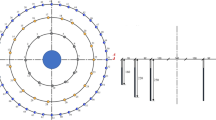Abstract
Blast vibration analysis constitutes the foundation for studying the control of blasting vibration damage and provides the precondition of controlling blasting vibration. Based on the characteristics of short-time non-stationary random signal, the laws of energy distribution are investigated for blasting vibration signals in different blasting conditions by means of the wavelet packet analysis technique. The characteristics of wavelet transform and wavelet packet analysis are introduced. Then, blasting vibration signals of different blasting conditions are analysed by the wavelet packet analysis technique using MATLAB; energy distribution for different frequency bands is obtained. It is concluded that the energy distribution of blasting vibration signals varies with maximum decking charge, millisecond delay time and distances between explosion and the measuring point. The results show that the wavelet packet analysis method is an effective means for studying blasting seismic effect in its entirety, especially for constituting velocity-frequency criteria.
Similar content being viewed by others
References
ZHANG Xian-da, BAO Zheng. Non-stationary Signal Analysis and Processing [M]. Beijing: Defence Industry Press, 1998. (in Chinese)
WANG Hong-yu. Non-stationary Random Signal Analysis and Processing [M]. Beijing: Defence Industry Press, 1999. (in Chinese)
HE Jun, YU Ya-lun, LIANG Wen-ji. Wavelet analysis for blasting seismic signals [J]. Chinese J of Geotechnical Engineering, 1998, 20(1): 47–50. (in Chinese)
Charles K, Chu I. An Introduction to Wavelets [M]. Academic Press Inc, 1992.
Cohen L. Time-Frequency Analysis: Theory and Application [M]. Prentice-Hall, 1995.
Daubechies I. Orthonormal bases of compactly supported wavelets [J]. Commun Pure and Appl Math, 1988, 41(7): 909–996.
ZOU Yun-ping, LI Xiao. Signals Transform and Processing [M]. Wuhan: Huazhong University of Science & Technology Press, 1993.
HU Chang-hua, ZHANG Ju. System Analysis and Processing based on MATLAB-Wavelet Analysis [M]. Xi’an: Xidian University Press, 2000.
HE Ling-song. Characters of wavelet and its affection to the result of wavelet transform [J]. Journal of Vibration Engineering, 2000, 13(1): 143–146.
Mallat S G. A theory for multi-dimension signal decomposition: the wavelet models [J]. IEEE Trans Pattern Analysis and Machine Intell, 1989, 11: 674–693.
Daubechies I. The wavelet transform time-frequency localization and signal analysis [J]. IEEE Transactions on Information Theory, 1990, 36(5): 961–1005.
LOU Jian-wu, LONG Yuan, XU Quan-jun. Study on the wavelet analysis applied in structure response to blasting vibration [J]. World Information on Earthquake Engineering, 2001, 17(1): 64–68.
Author information
Authors and Affiliations
Corresponding author
Additional information
Foundation item: Project(50490272) supported by the National Natural Science Foundation of China; project(2004036430) supported by the Postdoctoral Science Foundation of China
Rights and permissions
About this article
Cite this article
Ling, Th., Li, Xb., Dai, Tg. et al. Features of energy distribution for blast vibration signals based on wavelet packet decomposition. J Cent. South Univ. Technol. 12 (Suppl 1), 135–140 (2005). https://doi.org/10.1007/s11771-005-0387-0
Received:
Accepted:
Published:
Issue Date:
DOI: https://doi.org/10.1007/s11771-005-0387-0
Key words
- blasting vibration
- non-stationary random signal
- energy distribution
- wavelet transform
- wavelet packet decomposition



